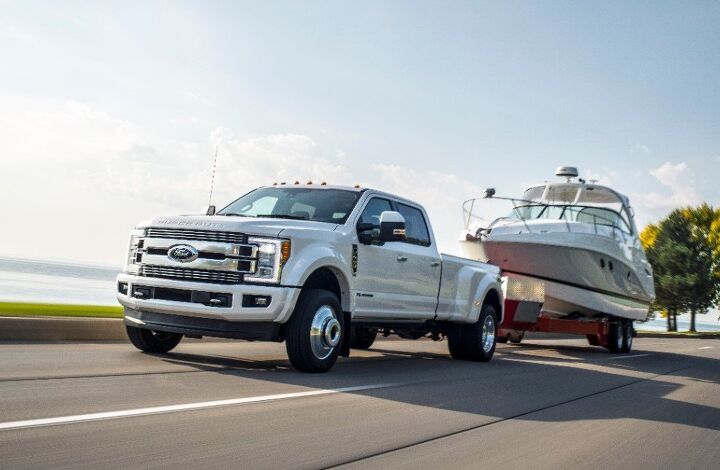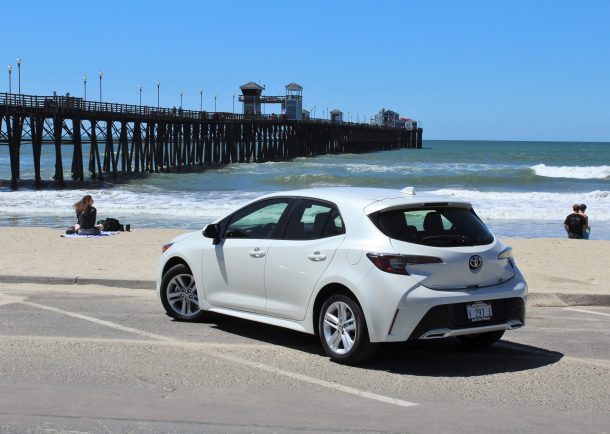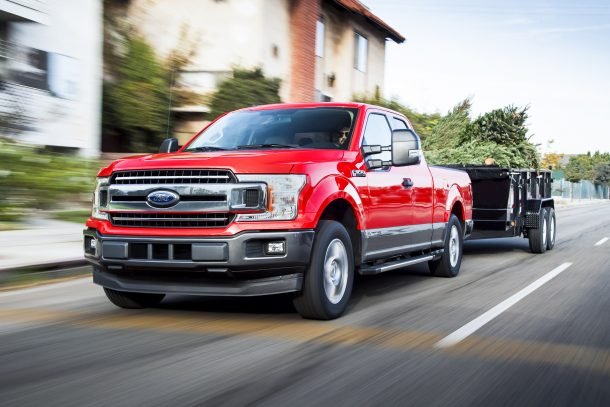#FuelEconomy
Blue Oval Vs Big Green: Environmental Ad Campaign Lays Into Ford … Again
The builder of the world’s best-selling vehicle, which just happens to be a large truck, finds itself in the crosshairs of yet another environmental ad campaign. Like past campaigns against the automaker, the coalition of four leading environmental groups claim Ford’s commitment to the environment pales in comparison to its thirst for profits.
Oh, and Ford Motor Company might as well change the name on its logo to “Trump.”
That’s what readers of The Detroit News and Detroit Free Press read on Saturday morning, after the Sierra Club (which is not a British Ford fan group, to be clear), Greenpeace, Safe Climate Campaign, and Public Citizen ran giant ads in both newspapers slamming the automaker for backing the Trump administration’s planned rollback of fuel economy standards.
Whoa, whoa, whoa, take it easy, Ford responded.
Gabbing on Gas: White House and California Still On Speaking Terms
Despite the growing animosity, both California and the Trump administration are still willing to discuss the country’s changing emission regulations. The state is currently heading a lawsuit against the Environmental Protection Agency, claiming it “acted arbitrarily and capriciously” in overturning the previous administration’s decision to maintain Corporate Average Fuel Economy standards.
While the proposals issued by the current administration will eventually see those targets rolled back, a final decision has not been made. The White House claims it wants to maintain an open dialogue with the Golden State, hoping to reach an agreeable solution, but the California Air Resources Board has argued it doesn’t seem to be acting on those assertions. Meanwhile, EPA head Scott Pruitt maintains that the state will not dictate federal fueling rules as automakers beg the government to do everything in its power to ensure a singular national mandate.
It’s an ugly situation, which makes news of a new round of meetings all the more surprising.
Before E-Power Makes It Here, Nissan First Has to Send It to the Gym
Whether the buying public likes it or not, there’s a tsunami of electrified powertrains headed for U.S. shores. Automakers the world over hope to beat their rivals in the race to a “fully electrified” lineup, which just means there’ll be — at a minimum — a hybrid variant in each model line.
It’s far less sexy than headlines make it sound. Still, if you’re into technology and saving money at the pumps (not necessarily at the dealer), it’s hot stuff. Nissan’s taking an unconventional route in this race, forgoing a conventional hybrid setup for an inexpensive stopgap solution all its own.
The system, called e-Power, is already a hit in Japan. But before it makes its way into high-end Nissan products (read: Infiniti), it first needs to upsize the system for American-sized vehicles travelling at American-sized speeds. That’s not as easy as it sounds.
This is a Mess: EPA Begins Quest to End California's Fuel Waiver
The Trump administration has enacted phase two of its plan to revise Obama-era rules designed to cut pollution from vehicle emissions. In a proposal sent to the White House Office of Management and Budget on Thursday, the Environmental Protection Agency announced its intention to rescind the California waiver that separates it from the federal standards the state uses to regulate greenhouse gas emissions from automobiles.
Since allowing California to set its own emission standards would effective split the country’s auto market, the EPA has been clear that its ideal solution would be to cut a deal with the Golden State. Agency head Scott Pruitt previously said California “shouldn’t and can’t dictate [fueling regulations] to the rest of the country,” but acted in a manner that suggested a compromised could be reached.
This was followed by a lawsuit filed by 17 U.S. states, along with the California governor’s office, California attorney general, and the California Air Resources Board (CARB), alleging that the EPA had “acted arbitrarily and capriciously” in its decision to roll back the previous administration’s decision. While the odds are good that the Trump administration wasn’t ever interested in bending to California’s more stringent pollution policies, this was likely the point of no return — squashing any hope for meaningful negotiations.
Rebuking the Rollback: Science Advisors Claim EPA Ignoring Its Own Fuel Economy Research
Several science advisers for the Environmental Protection Agency claim the agency has ignored its own research in order to rationalize the push to relax corporate average fuel economy (CAFE) targets.
A group within the Science Advisory Board has recommended reviewing the EPA’s justifications for the intended rollbacks, including the agency’s conclusion that Obama-era auto efficiency requirements must be changed because they are too stringent. It’s hoping to take the agency to task and force it to show evidence that upholds is proposal.
While EPA head Scott Pruitt sides with the President and automotive industry by indicating the current standards are too strict, very little scientific research has been cited to support the claim. In fact, the revision seems to hinge mainly on the belief that automakers might not be able to adhere to the standards approved by the Obama administration in its final days. “Obama’s EPA cut the midterm evaluation process short with politically charged expediency, made assumptions about the standards that didn’t comport with reality, and set the standards too high,” Pruitt said in April.
2019 Toyota Corolla Hatchback Pricing Announced; Big MPG Gains Await Those Who Hate Shifting
With a new body, platform, wheelbase, engine, and continuously variable transmission, the 2019 Toyota Corolla Hatchback (formerly the Corolla iM) is a very different beast than its predecessor. This was made abundantly clear during our recent test drive. Gone is the weird seating position, the spartan interior, and the so-so ride.
Just as important, the iM’s lackluster power figures give way to decent specs for a car of its class. It seems Toyota actually listened to owner complaints, boosting the vehicle’s output by 31 horsepower and 25 lb-ft while adding a physical launch gear to the new CVT, all in the hopes of wringing a little fun out of the compact liftback.
Here’s what getting into a Corolla Hatch costs:
Automakers to White House: Make a Deal With California on Fuel Economy
Despite pressuring Donald Trump to lower corporate fuel economy mandates since practically day one of his presidency, automakers are now urging caution. The U.S. Transportation Department has drafted a proposal that would freeze vehicle requirements at 2020 levels through 2026, the Environmental Protection Agency’s lead administrator made a public case for rolling back mileage targets, and the White House seems ready to help car companies lower the bar.
Automakers seem to have won, so why the change of heart?
Four-cylinder Jeep Wrangler Packs on the MPGs
The 2018 Jeep Wrangler JL is not the inline-six-powered, aerodynamic brick it was in years past. For the current generation model — now the only Wrangler built in Toledo — Jeep’s Jeepiest Jeep saw a host of improvements designed to lighten its curb weight, reduce aerodynamic drag, and cover more ground on a gallon of gas.
The model launched with only the 3.6-liter Pentastar V6 under its hood, aided in its fuel-sipping mission by standard stop/start and an eight-speed automatic transmission. Depending on the model and tranny, combined fuel economy rose 2 mpg between the old JK and newer JL models, and highway mileage rose as much as 4 mpg.
Finally, we now have EPA figures for the turbocharged 2.0-liter four-cylinder Wrangler.
Lawmakers Demand MPG Details, States File Lawsuit Against EPA
America’s gas war is heating after 17 states, as well as the District of Columbia, filed a lawsuit against the Environmental Protection Agency’s decision to redefine U.S. vehicle emissions and fuel efficiency rules through 2025.
In April, EPA chief Scott Pruitt said the existing standards for model year 2022 to 2025 vehicles should be revised. The suit, filed in the U.S. Court of Appeals for the District of Columbia, alleges the EPA acted unpredictably, failed to follow its own regulations, and was in direct violation of the Clean Air Act. New York Attorney General Eric Schneiderman claimed the “Trump administration conducted a phony study” to justify altering emission rules to appease automakers and the oil industry.
Meanwhile, U.S. Representatives Doris Matsui of California and Paul Tonko of New York are demanding the EPA hand over all documents related to the study that resulted in the proposed changes to fuel economy standards.
EPA Head Defends Fuel Economy Rules, Industry Ties On Capitol Hill
Environmental Protection Agency chief Scott Pruitt spent the majority of his Thursday being raked over the coals by the House Energy and Commerce subcommittee before a second (even uglier) exchange with the House Appropriations subcommittee. The majority of the time was spent addressing concerns surrounding Pruitt’s expenditures — things like unnecessary first-class travel, a $43,000 soundproof phone booth, and his 24-hour security team. There were also discussions about alleged death threats against Pruitt and EPA staff, his overall conduct, and even a little bit on environmental policy.
Those discussions, however, saw some subcommittee members accuse Pruitt of championing the profits of oil companies and automakers over the wellbeing of the planet. The EPA head spent the duration of Thursday defending his actions, including planned regulatory rollbacks on fuel economy. He also supported the automotive industry’s proposal to abolish 87 octane and replace it with 95.
As ugly as the day was for Pruitt, Republicans occasionally hopped on the mic to gently support him. Rep. Kevin Cramer of North Dakota said, “I think the greatest sin you’ve done is, you’ve actually done what President Trump ran on.”
Next-generation Volkswagen Golf to Offer Electric Assist, but Just a Tad
Audi is bullish on 48-volt mild hybrids, and its Volkswagen sister division is no different in wanting to see larger batteries take some of the load off of its internal combustion powerplants.
The automaker announced Thursday that its upcoming eighth-generation Golf will offer a low-cost alternative to purely gas- or diesel-powered motoring. The mild hybrid system appearing on that vehicle, due next year as a 2020 model, will soon spread throughout the VW lineup, the automaker claims.
Can It Be? Mazda's Long-awaited CX-5 Diesel Gets California Green Light
We’ve been talking about the Mazda CX-5 diesel for a long time, and with good reason. It’s been a long time coming. Originally promised for a U.S. introduction in the second half of 2017, a quick scan of of Mazda’s consumer website reveals no mention of a popular compact crossover with a 2.2-liter Skyactiv-D four-cylinder under the hood.
This could soon change. The California Air Resources Board has certified the engine for sale in that ecologically sensitive state, making a similar thumbs up from the Environmental Protection Agency a near certainty.
Appeals Court Says Trump Cannot Delay CAFE Penalties
During the Trump administration’s year-long quest to roll back Corporate Average Fuel Economy (CAFE) targets, it attempted to give automakers in violation of the current standards a break by delaying the scheduled increase of penalties. The logic here is that the federal government is reassessing the Obama era standards, so it lumped in the new fines that were supposed to go into effect last July.
Those penalties represent an increase of $8.50 for every tenth of a mile per gallon a new car consumes above the minimum fuel standard. But with the new targets in quasi limbo, the updated fines were not being applied.
On Monday, a federal appeals court ruled the Department of Transportation cannot do that. Since the old rules are technically still in effect, the court ruled that automakers are still subject to the fine.
Now, About Ford's Upcoming F-150 Diesel…
Ford was all but gloating… okay, it was gloating when it unveiled the coveted “30 mpg highway” figure for the upcoming 3.0-liter Power Stroke diesel V6 earlier this week. A full-size pickup with a 30 mpg rating? That sets it apart from all others, including the 27 mpg (highway) Ram 1500 EcoDiesel.
What the automaker didn’t mention was how much green you’ll need to shell out for a Power Stroke-powered F-150. Well, the beans are now spilled, but the product positioning seems a little odd.
Green Oval? Ford Claims Top MPG Marks for Upcoming F-150 Diesel
Ford Motor Company claims its 3.0-liter Power Stroke diesel V6, due to appear under the hood of the F-150 starting in May, blows the competition out of the water in terms of fuel economy. The automaker now cites an EPA-estimated 30 mpg highway figure for its light-duty diesel pickup, beating Ram’s 3.0-liter EcoDiesel in pump-passing power.
The real test, however, comes later this year, when General Motors debuts its own light-duty Duramax mill — a Flint-built diesel inline-six of unannounced power and efficiency.





























Recent Comments